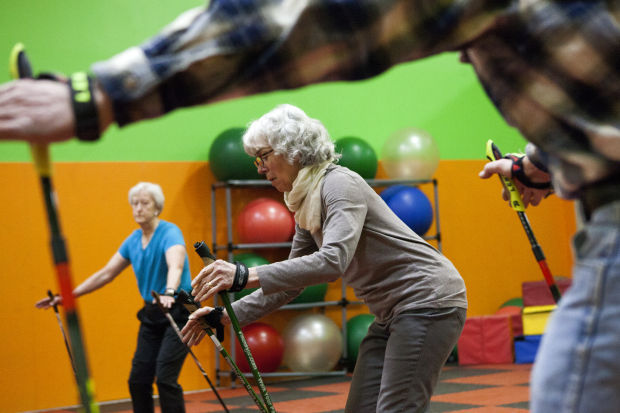
The workout looks out of place: participants strap poles on their hands and glide around a gym mimicking the movements of cross-country skiing.
The exercise — Nordic walking — is catching on in the area.
Not to be confused with the generic term pole walking, Nordic walking is a specific technique that was developed as a summer training exercise for Nordic (or cross-country) skiing.
The exercise enhances the natural walking stride with the addition of specially designed poles, which can increase a person’s exertion level by 30 to 40 percent.
Twice a week Desyl Peterson instructs a class on the activity at the YMCA of Rapid City.
Participants grab a pair of Nordic poles and start hiking their way around the gym.
Prior to the workout, Peterson adjusts the poles to the correct height for each person and sends them on laps around the gym.
Many participants are Parkinson’s patients who find the low-impact workout highly effective in creating a full-body workout.
Some form small groups of two or three people, socializing as they work out. Others, like longtime rancher Darrell Bentz, take a more solitary route, making laps around the gym with determined strides.
The cardiovascular activity has numerous benefits, according to Peterson, including improving posture and strengthening the core. One of the best parts of Nordic walking is that it can be done almost anywhere.
The technique is relatively simple, as it’s based on natural walking stride, but beginners can over think the process and hold themselves stiff and tense. Or they tend to hold the poles too tightly, according to Peterson.
“You don’t need a death grip,” she said, “or you end up with sore hand muscles.”
Little equipment is needed for the workout.
“A good pair of poles can cost about $80 to $120. Replacement rubber tips are a nominal cost of about $10 to $15,” Peterson said. “The only other equipment needed is a good pair of walking shoes, which I replace about every three months.” The poles can be ordered online.
In 2006, while living in Minnesota, Peterson was introduced to Nordic walking by a friend and quickly was hooked.
“I loved the simplicity, peacefulness, and efficiency of this form of exercise,” she said. She also loved the fact that it’s noncompetitive, can be enjoyed as a social activity or alone, and it’s simple.
In the fall 2012 she took an instructor class. She has been teaching Nordic walking here since November 2014.
“The Nordic walking allows longer period of mobility without fear of falls,” she said talking about the benefits for Parkinson’s patients. “It allows a chance to practice rhythmic movements, and builds confidence.”
Kelly Lane, who is mostly confined to a wheelchair because of Parkinson’s, and can’t walk without the poles, finds that Nordic walking allows him to have mobility again. Not only does he do steady laps around the gym on his own, but he can also enjoy hiking on the local trails, like Skyline Wilderness Park and Hanson-Larsen Memorial Park.
Peterson recommends Nordic walking to everyone, even children can participate. Runners who have injured themselves, older adults, patients recovering from surgery, and patients with neurological disorders such as Parkinson’s all can benefit from the workout.
“It’s so easy to do,” Peterson said. “You can just go out your door, and you’re off for a great, low-impact workout.”
Source: Rapid City Journal
February 21, 2015
By: Christy Hammond










